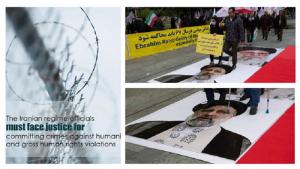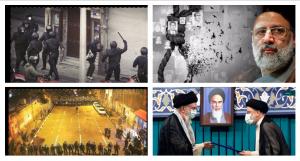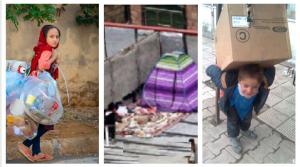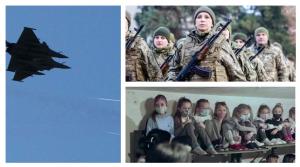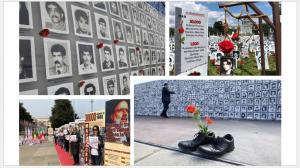One year after the Iranian regime’s Supreme Leader installed an illiterate mass murderer as president and consolidated power in all three branches of power, he declared war on Iran’s society and the international community.
Since taking office, 522 people have been executed, almost 100% increase in the number of executions with respect to the year before that. The unprecedented executions of at least 21 women and seven minors. 2,000 were detained for political reasons.
Prices also rose for all components: housing & utilities 31.4%, transport 43.1%, furniture & household equipment 34.7%, clothing & footwear 48.7%, miscellaneous goods & services 36.3%, and health 36.9%.70% of Iranians live below the poverty line.
Tehran hurriedly expressed support for the Ukraine invasion, offered to help Moscow by evading international sanctions, and sold drones to the Russian military. But yet it failed to fix the energy rivalry problem with Russia which is a serious obstacle.
After three years, the Swedish Judiciary handed down its verdict, sentencing to life one of the perpetrators of genocide and crime against humanity in the massacre of 1988. There have been also international calls for the prosecution of Raisi.
Since taking office, 522 people have been executed, almost 100% increase in the number of executions with respect to the year before that.
Despite the regime’s crackdown, the MEK’s Resistance Units continue to expand across the country. Their activities include leading popular protests and destroying the regime’s symbols of suppression.”
— NCRI
PARIS, FRANCE, August 8, 2022 /EINPresswire.com/ -- One year after the Iranian regime’s Supreme Leader installed an illiterate mass murderer as president and consolidated power in all three branches of power, he declared war on Iran’s society and the international community.
Unable to compromise with the global community and unwilling to solve socio-economic problems, under Raisi’s watch, the people of Iran got poorer, and their protests became more radicalized. On the other hand, the Iranian Resistance grew stronger and expanded its network inside Iran’s agitated society.
Human Rights Abuses:
• Under Raisi, human rights abuses have dramatically worsened.
• Several human rights organizations joined in a campaign this past week to call attention to what they called a “horrifying wave” and a “spree” of executions in Iran.
• Since taking office, 522 people have been executed, almost 100% increase in the number of executions with respect to the year before that.
• The unprecedented executions of at least 21 women and seven minors.
• The public hanging of a political prisoner on July 23 was the first public hanging after two years.
• Arbitrary death of at least 100 prisoners.
• At least 18,144 people were arrested, 2,000 detained for political reasons.
• Five cases of flogging and two cases of amputation of limbs during the past two months.
• The recent crackdown on women intensified their suppression in the framework of the medieval decree entitled ‘chastity and hijab.’
Economy:
• The annual inflation rate in Iran surged to 52.5 percent in June 2022 from 39.3 percent in the previous month, reaching the highest level since July 1995, with food & non-alcoholic beverages prices accelerating to 82.6%, the most since April 2019.
• Prices also rose for all components: housing & utilities 31.4%, transport 43.1%, recreation & culture 31.5%, furniture & household equipment 34.7%, clothing & footwear 48.7%, miscellaneous goods & services 36.3%, and health 36.9%.
• Low growth, high inflation, and widespread un- or underemployment have diminished the purchasing power of many income deciles, causing widening income inequality.
• The Iranian currency, the rial, has depreciated by about 15 percent against the US dollar since Raisi took over.
• A year into Raisi’s term, the state-run daily Sharq wrote, “Reports from the Ministry of Labor show that about 60% of Iranians do not have sufficient income and suitable jobs. About 14.2 million Iranians have low-income jobs and are without insurance.” The paper added, “About 25 percent, or one-fourth, of the population, are slum dwellers and homeless.”
• Some 70% of Iranians live below the poverty line. At least 12 million sleep hungry every night.
• Even state-run news outlets admit to the critical state of society. “Skyrocketing prices, rampant inflation, and the constant devaluation of the national currency are testaments to the ineptitude of those officials who came to power with the promise of rapidly resolving people’s problems. Now, they are facing popular protests,” the state-run Jomhuri Eslami daily wrote on June 16.
Foreign Policy
• In the early days of his presidency, Ebrahim Raisi announced he will implement the “look towards East policy” and strengthen the ties with regional countries. Practically, despite formal expenditures and proactive lip service, his diplomatic apparatus failed to build new bonds and got Tehran more isolated.
• Multiple meetings across the Middle East did not help the regime to prevent the formation of a new regional alliance against itself and multiple political, economic, and military coalitions are currently in the making to combat Tehran’s malign influence in the region.
• Instead of investing at home, Tehran continued to spend scarce capital on regional militant groups but still, its allies in Iraq and Lebanon failed to secure power in Baghdad and Beirut and its proxies in Yemen also suffered serious military setbacks on the ground. Hence, the regime resorted to more political blockage as well as terrorist attacks whereby it gained more fury from regional leaders.
• Despite one-sidedly spending geostrategic capital, the Iranian regime failed to exploit the increasing animosity between the West and the Asian powers, Russia and China.
• Tehran hurriedly expressed support for the Ukraine invasion, offered to help Moscow by evading international sanctions, and sold drones to the Russian military. But still, it failed to fix the energy rivalry problem with Russia which remains a serious obstacle.
• The clerical regime also tried hard, mostly by squandering national wealth, to gain China’s backing in easing the pressure of international sanctions.
Yet it failed again to persuade Beijing to risk international forfeit because of Tehran.
• Despite an official policy of rapprochement in the West towards Tehran, due to the regime’s lack of cooperation and failure to abandon regional warfare or even signal intent to ease tensions, more sanctions were imposed on the regime, and it got more isolated in the last 12 months under Raisi.
Nuclear ambitions
• Despite Tehran’s official statements about aiming to resume the nuclear talks with P4+1 as well as negotiating indirectly about sanction relief with Washington, Ebrahim Raisi’s nuclear team did nothing but waste time in eight lengthy rounds in Vienna and Doha and practically killed hopes of a JCPOA revival.
• The regime overplayed its hand in the negotiations and thought it can force a war-fatigued Washington to concede everything on its wish list. Though the truth about Tehran’s ailing status at home and abroad was too visible for the West to surrender one-sidedly and the regime intensified its extortion tactics through nuclear advancements and reducing cooperation with the UN’s nuclear watchdog.
• The IAEA Board of Governors censured the Iranian regime on June 8, 2022, and Tehran is expecting more condemnation in the next BoG meeting in September. Solely relying on Russia and China’s veto power in the United Nations Security Council, the regime is now trying to incentivize both regimes to shield itself against a potential UNSC Resolution Charter 7.
• Wary of more exposure or military attacks against its nuclear sites, the regime is now openly threatening with building nuclear warheads. Multiple state officials are constantly expressing warnings and want to convey the message that Tehran has already joined the nuclear club and the world has no other option but to surrender to the regime’s blackmail.
Response by the people and Resistance:
• Despite the surge in executions and repression, the Iranian people are not intimidated. At least 9,630 protests and uprisings have been registered, 809 more than the year before.
• There have been at least 34 nationwide protests by teachers, pensioners, and retirees across Iran.
o Teachers held 17 large-scale rallies in over 100 cities in 31 provinces.
o Retirees took to the streets nationwide on 17 different occasions in 20 provinces.
• In May, major protests broke out across Iran, after Raisi’s government cut subsidies for food, sending prices through the roof as authorities braced for more unrest.
• November 2021, the people of Isfahan took to the streets in support of the Isfahan farmers who had protested the drawth due to the regime’s unpatriotic measures in diverting the river to IRGC’s industries.
The protesters clashed with the regime’s notorious forces who used pellet guns blinding at least a dozen and wounding hundreds.
• The protests in Abadan for several weeks, over the collapse of Abadan Metropol’s complex and the death of dozens because of the officials’ corruption and plundering. The protests quickly spread to many cities in the province.
• Merchants in Tehran’s Bazaar went on strike in June 2022, over the increase in prices and the government taxes.
• Protests have increased as Raisi failed to address deteriorating living conditions a year into his term.
• Iran’s people have not succumbed to the barbaric crackdown of peaceful protests by teachers, taxi drivers, workers, pensioners, and other social sectors during Raisi’s tenure.
• With growing protests and the regime’s inability to contain them, Khamenei openly threatened the protesters with a harsh crackdown on dissent. The most prevalent chant in the protests was “death to Khamenei and Raisi.”
Expansion of Iranian Resistance’s Activities:
• Despite the regime’s crackdown, the MEK’s Resistance Units continue to expand across the country. Their activities include leading popular protests and destroying the regime’s symbols of suppression.
• During Raisi’s term, these Resistance Units have carried out at least 2,350 acts of resistance against the regime symbols of repression in various towns, 85% percent of them successfully.
• During a recent gathering of the National Council of Resistance of Iran (NCRI), video clips of some 5,000 Resistance Units voicing support and expressing their commitment to a free and democratic Iran were displayed, showing a five-fold increase in the number of the Resistance Units sending messages of support relative to last year.
The 1988 Massacre:
• After nearly three years, the Swedish Judiciary handed down its verdict, sentencing to life one of the perpetrators of genocide and crime against humanity in the massacre of political prisoners in 1988.
• There have been international calls to also prosecute the current leaders of the regime, including Khamenei and Raisi, for committing crimes against humanity, war crimes, and genocide.
Raisi’s Background:
• Ebrahim Raisi took office as the Iranian regime’s president on August 3, 2021.
• Despite Raisi’s notoriety as a vicious human rights violator, Ali Khamenei, the regime’s Supreme Leader, engineered his “election” as president to consolidate power. In addition to seeking to unify his faltering regime, Khamenei’s primary intent for choosing Raisi was to quell protests and intimidate the restive society into silence as crises and popular protests continued to mount, bringing Iranian society to the verge of explosion.
• Since the age of 19, Raisi, who lacks formal education, acted as an interrogator and prosecutor in various Iranian prisons, including Karaj and Hamedan, where thousands of political prisoners were tortured and executed under his watch.
• As a member of the ‘death commission’ in Tehran, Raisi was directly involved in the massacre of at least 30,000 political prisoners in 1988, 90% of whom were supporters and members of the main opposition the People’s Mojahedin Organization of Iran (PMOI / MEK). He has been dubbed by people as the “1988 Henchman.”
• The Iranian people overwhelmingly boycotted the sham elections, which saw the lowest turnout ever, even with hugely inflated official tallies.
Conclusion:
• Khamenei and his regime are at a deadly impasse and cannot resolve increasing crises at home and abroad.
• Neither Raisi nor a potential nuclear weapon can save the regime because the restive population does not accept the regime.
• Khamenei’s strategy of using Raisi as the bogyman has miserably backfired as Iran protests are getting ever closer to achieving their goal, regime change for freedom and democracy.
Raisi’s policy has been a disaster on the economic front as mismanagement, incompetence, and corruption have led to a tanking economy and a catastrophic environmental crisis, including water shortages, floods, and other calamities.
Shahin Gobadi
NCRI
+33 6 61 65 32 31
email us here
![]()


